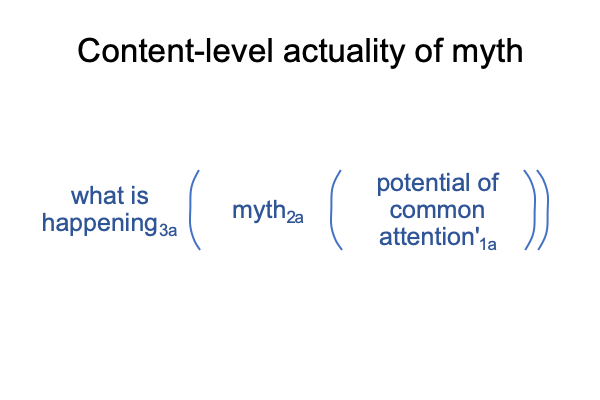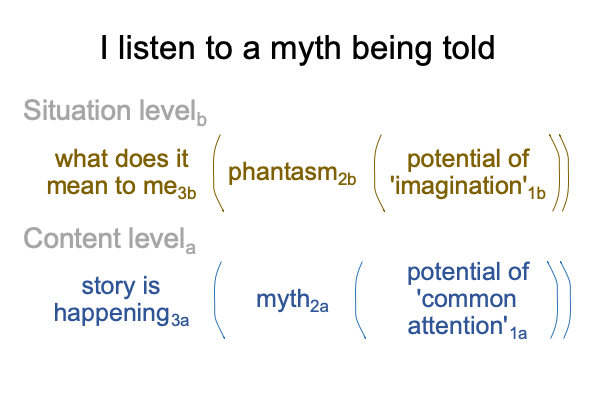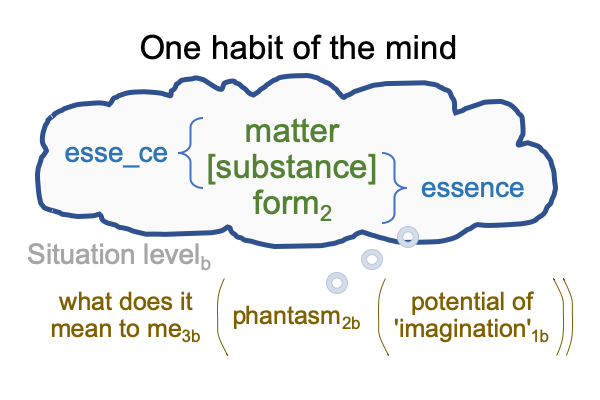0040 The esse_ce and essence of myth coheres to the dyadic structure of Peirce’s secondness. It also expresses Aristotle’s hylomorphism.
The esse_ce of myth is an intimation of a real world event.
The essence of myth is explored with Jungian psychology.
These two approaches complement one another.
0041 What does this have to do with monsters?
Monsters appear in myths. And, we perceive them as monsters.
There are monsters in the content of myth. Then, our perception constructs thier monstrosities.
0042 On the content-level, the myth, a story told by a story-teller, is an actuality2, emerging from the possibility of common attention1, in the normal context of what is happening3.
The following formula is introduced in A Primer on The Category Based Nested Form. In a normal context3, an actuality2 emerges from (and situates) the possibility of ‘something’1. The subscripts refer to Peirce’s categories.
0043 Here is a picture.

A situation level emerges from (and situates) a content level, according to A Primer on Sensible and Social Construction.
Monsters appear as content in myths.
This content is then situated by the human imagination.
0044 A myth2a is situated by possibilities inherent in the imagination1b, giving rise to a phantasm2b, in the normal context of what it means to me3b.
The two-level interscope is typical for sensible construction.

0045 Each column produces a virtual relation.
The imagination1b virtually emerges from (and situates) common attention1a.
Phantasms2b virtually emerge from (and situate) the telling of a myth2a.
What does it mean to me3b virtually emerges from (and situates) what is happening in the story3a.
0046 Jungian psychology studies the ways that imagination1b situates myth1a. Imagination picks up on essence. Essence associates to form. More than that, essence goes with the filling in of a form (that is, [substance] form). The way that form is realized addresses the question, “What do the various features of the story mean to me3b?”
But, the phantasm2b is not pure fantasy. It is not solely essence. The imagination also brings experience into the picture. For this reason, the child perceives a myth as literally true and the adult senses that the myth is a mix of fact and fiction. The more experience one has, the more important the matter that goes into the story becomes. Or, should I say, “being”?
0047 Experience includes one’s own personal accounts. Experience includes one’s traditions. Experience includes encounters described in myth. Experience is both practical and theoretical.
Experience tells us that something real is going into the essence of the myth. The esse_ce may be taken to be literal (making the story a historical documentation) or figurative (making the story a fantasy) or any mix of the two (bringing us back to the continuum in the first blog).
There is a continuum between matter, which is material, and being, which is immaterial.
Both contribute to esse_ce.
0048 So, what is going on in one’s head when one encounters a myth?
The mind3b constructs a phantasm2b that appropriates the structure of Aristotle’s hylomorphism. Actuality is dyadic. A myth2a is actual. So, the phantasm2b uses imagination1b to construct the same dyadic structure, but in a way that reveals the monstrosity1b in monsters2a.
0049 Here is a picture of what the phantasm constructs.

